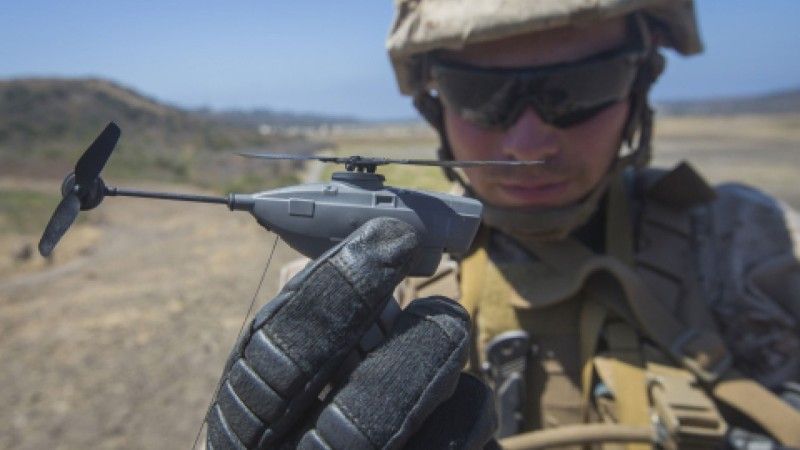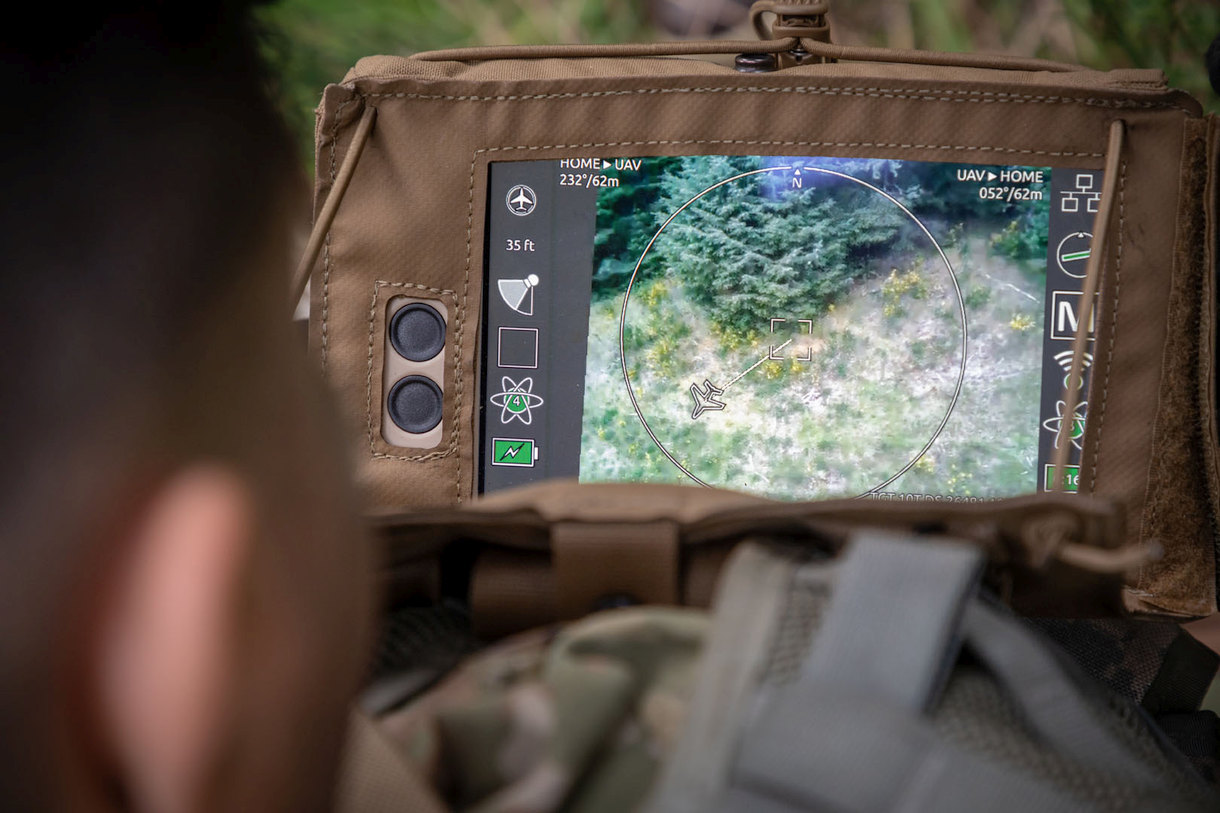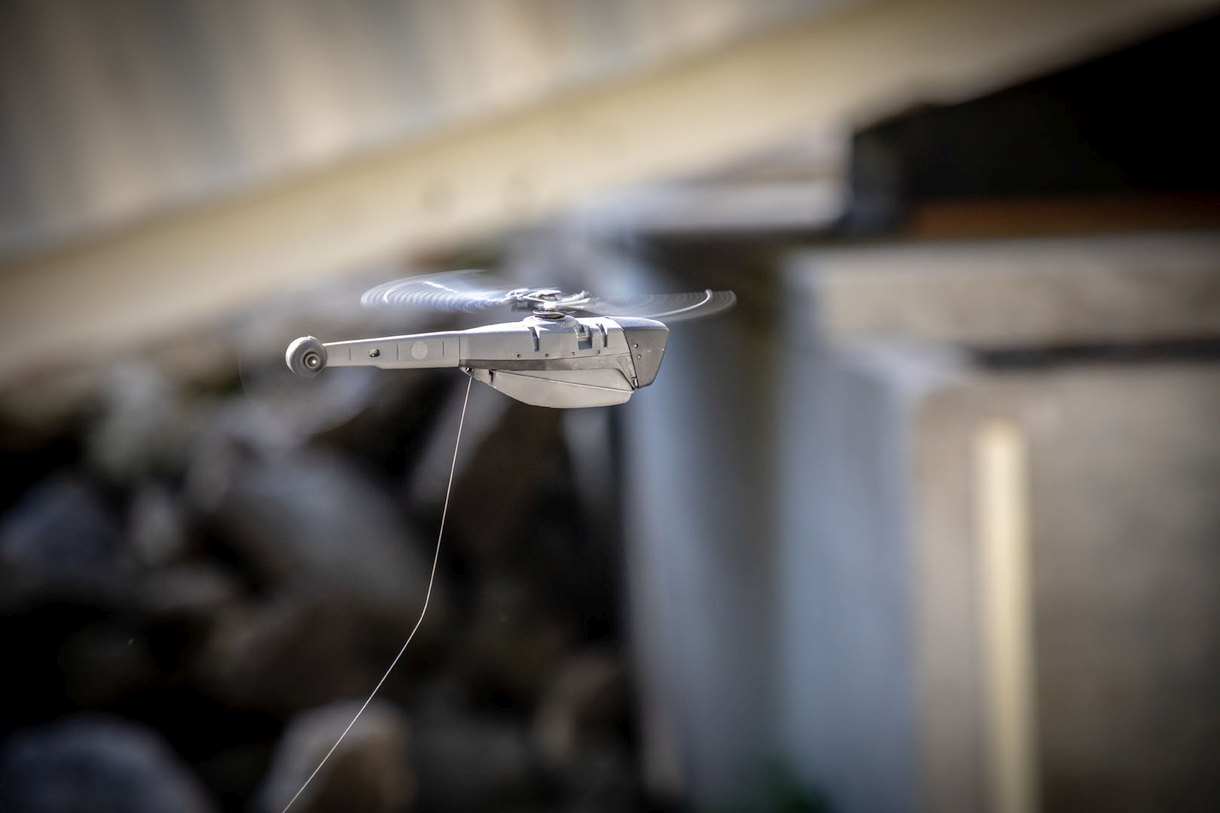Strona główna
Microdrones for military. Black Hornet for Polish Commando Unit

Obtaining a high degree of situational awareness is one of the priorities for the contemporary infantry or special operations forces. It is required to carry out the mission effectively. Thus working with small UAVs or land robots that provide ISR data in real time remains incredibly relevant. Furthermore, activities as such also raise the level of operational safety for the own safety of the user. PD-100 Black Hornet micro UAV is one of the best known drones designed to act in this role.
One of the requirements defined for a system as such is for it to be capable of gathering intelligence on the enemy forces that remain close to own forces. Systems such as the Black Hornet need to be lightweight (weighing less than 200 grams), have a minimum range of more than 500 meters and offer more than 15 minutes of endurance.
PD-100 Black Hornet in a personal micro-UAV designed for close reconnaissance purposes. Its main task is to raise the level of operational awareness for a single operator or a small element, such as section, squad or platoon. PD-100 is the smallest solution of its kind on the market operated by several armies and uniformed services already.
Black Hornet UAV has been developed by the Norwegian Prox Dynamics company. It is currently offered by FLIR Systems that acquired the Prox Dynamics company back in 2016. It is estimated that more than 8 thousand Black Hornet miniaturized drones have been delivered to the users already.
The system’s purpose is to carry out reconnaissance activities, supervise the zone of operations within the scope of safety procedures, be used for observation, intelligence gathering or rescue operations support. Black Hornet is relatively simple to use and it does not require complicated training or peculiar skills. Basic operator training aimed at teaching him/her to handle the drone and develop proper habits takes only 2 days.
Dangerous “Toy”
The idea to create this micro helicopter-design UAV was born back in 2008, and it was also a moment when the first design works began. After 3 years of research and testing the PD-100 went into series production.
The first variants of the Black Hornet drone weighed 16 grams while the rotor had a diameter of 120 mm. The UAV in question has an aerodynamic shape and its design has been based around a durable plastic housing. The first variants could attain maximum range of up to 1000 meters. There was an option to control the drone manually and it may have also flown around a pre-planned route. Maximum ceiling of the first variants was defined as 300 meters, with endurance of around 30 minutes.
Black Hornet Nano version II (weighing more than 18 grams) features structural reinforcements and exhibits enhanced performance. The UAV in question may be used at night and during the day, thanks to the fact that versions with different sensor sets have been developed (optoelectronic sensor or thermal imaging device). The UAV does not have an internal memory storage though. However, this is acceptable, as a UAV as such could also be potentially intercepted by the adversary.
The batteries powering the electric motor are replaceable. Furthermore, the UAV may also be operated in areas where no GPS signal is available while the proprietary Vision Base Navigation system can be used to fly indoors. The drone can be readied for take off in 30 to 120 seconds. It offers up to 25 minutes of endurance. Despite the system’s low weight the manufacturer declares wind resistance at the level of 10 m/s and weather sealing protecting the UAV from rain (2.5 mm/h level of precipitation). The temperature range within which Black Hornet could be used is defined as -10°C to +43°C with humidity ranging from 10 to 90 %.
FLIR Black Hornet PRS weighing 32 grams can carry three cameras. The FoV ranges from 18.50 above the horizon and 118.50 below the horizon. TV cameras are used offering resolution of movies at the level of 640×480 pixels. They may also capture HD stills (1200×1600 pixels) or thermal imagery (160×120 pixels). The imagery is transmitted via an encrypted connection in real time.

The new variant has maximum range of up to 2000 meters and top speed of 21.6 kilometers per hour. The UAV is 168 mm long and the rotor diameter is 123 mm. This dimensions make it truly a pocket-size drone. A single set consists of two UAVs, operator’s console (controller with a 7 inch display), batteries and extra accessories, weighing up to 1 kilogram. The system makes it possible to use vector maps and raster maps for the purpose of increasing the precision of navigation and mission capabilities.
Black Hornet PRSis usually delivered in graphite color. Batteries can be charged in around 25 minutes which means that a set of two drones makes it possible to stay in the air almost continuously.
Black Hornet’s Users
The micro-UAV in question has been already introduced into the inventory of the Australian, Dutch, Indian, German, Norwegian and British armed forces or uniformed services. French Army and US Forces are also a major user of the system, this includes the Marine Corps Forces Special Operations Command. (recently the USMC procured another batch of those systems) Unofficially the system is operated in 23 countries all around the world.
The British Forces have been using the system since 2013, for instance Brigade Reconnaissance Force stationed at Camp Bastion were utilizing these drones during the Afghan operations.
Between 2016 and 2017 the US Army acquired a batch of PD-100 Black Hornet drones along with two other competitor micro-UAV designs. These were being tested by the 10th Mountain Division stationed in Fort Hill, in extreme conditions. Another order concerning 60 examples of the system has been placed in 2018. At the moment the Army Contracting Command is working on equipping the US Army with 2400 examples of the latest PD-100 Black Hornet III Nano systems. The first UAV of this kind are to be handed off this year.

In the US Army the UAV in question serves as a personal short range reconnaissance system and it is being procured within the framework of a broader SBS programme (Soldier Borne Sensor). The goal is to equip every infantry squad with a set of micro-UAVs as such. An intensive training process has also been organized to teach the soldiers how to handle the system and to develop tactics of use in a variety of operational environments.
Black Hornet in the Polish Military
Polish Military Unit no. 4101 (Commando Unit based in Lubliniec) would be the first element in the Polish military to operate this miniaturized UAV. The procurement process concerning the nano-UAVs (40 sets of UAVs weighing less than 100 grams) has been launched some time ago. The estimated value of the procurement was defined as PLN 14 400 000 (VAT included) and the procedure was a limited tender. The criteria for awarding the order included price (weight of 60), quick delivery (weight of 20) and extended guarantee (weight of 20).
Criteria as such resulted in submission of a single offer placed by the Zielonka-based UMO Sp. z o.o. company, with a total value of PLN 14,379,999.86 (VAT included), winning the tender. The first UAV systems are expected to be received by the Polish military in November.
Summary
It seems that Black Hornet may be treated as an extension of the capabilities provided by contemporary sights, NVG systems or other observation systems used by individual soldiers or smaller elements. Whereas not only does this micro-UAV extend the range and area that could be monitored, it also allows the user to penetrate the areas that would not be reachable for conventional systems. Another important factor is the higher level of operator safety.
Undoubtedly, the individual drone kit concept will be evolving towards a higher level of autonomy and joint operations with other battlefield robots. Swarms of such drones could also be formed for specific purposes. Weight (that cannot exceed 65 grams) and dimensions would be the only design limitation. It is possible that nanotechnology could contribute to expansion of capabilities of systems as such, with the aforesaid requirements still met.